NOAA/WDS Paleoclimatology - Stambaugh - Burnt Mountain - PIRE - ITRDB MI019
This archived Paleoclimatology Study is available from the NOAA National Centers for Environmental Information (NCEI), under the World Data Service (WDS) for Paleoclimatology. The associated NCEI study type is Tree Ring. The data include parameters of tree ring with a geographic location of Michigan, United States Of America. The time period coverage is from 415 to 50 in calendar years before present (BP). See metadata information for parameter and study location details. Please cite this study when using the data.
- Cite as: Stambaugh, M.C.; Guyette, R.P.; Marschall, J.M. (2013-09-06): NOAA/WDS Paleoclimatology - Stambaugh - Burnt Mountain - PIRE - ITRDB MI019. [indicate subset used]. NOAA National Centers for Environmental Information. https://doi.org/10.25921/as9h-xf43. Accessed [date].
- Please refer to Credit tab for full citation information.
- doi:10.25921/as9h-xf43
- noaa-tree-5998
- NCEI DSI 1200_02
- NCEI DSI 1200_01
noaa-tree-5998
| Search Data |
|
| Download Data |
|
| Distribution Formats |
|
| Ordering Instructions | Contact NCEI for other distribution options and instructions. |
| Distributor | NOAA National Centers for Environmental Information
ncei.info@noaa.gov |
| Dataset Point of Contact | NOAA National Centers for Environmental Information
ncei.info@noaa.gov |
| Dataset Point of Contact | Data Center Contact
NOAA World Data Service for Paleoclimatology 828-271-4800 paleo@noaa.gov |
| Coverage Description | Date Range: 1535 CE to 1900 CE; Date Range: 415 cal yr BP to 50 cal yr BP; |
| Time Period | 1535 to 1900 |
| Spatial Bounding Box Coordinates |
N: 46.83
S: 46.83
E: -87.93
W: -87.93
|
| Spatial Coverage Map | |
| General Documentation |
|
| Associated Resources |
|
| Publication Dates |
|
| Data Presentation Form | Digital table - digital representation of facts or figures systematically displayed, especially in columns
|
| Dataset Progress Status | Complete - production of the data has been completed |
| Data Update Frequency | Data update frequency not available |
| Supplemental Information |
STUDY NOTES: NOAA Template Raw Measurements file added 2019-02-08.
ABSTRACT SUPPLIED BY ORIGINATOR: Land managers developing fire management plans in the eastern and southern United States lack quantitative information on historic fire regimes. Twelve new fire histories were developed from dated fire scars on trees from regions where no fire scar history data had existed before in the states of Alabama, Louisiana, Kentucky, Iowa, Wisconsin, and Michigan. Sites represent highly variable climates from extreme cold (with long snow cover duration) to subtropical. All sites utilized oak or pine recorder species that were collected from closed forest to open savanna structures. Pre-industrial mean fire intervals ranged from 3 to more than 35 years at sites that typically encompassed less than 2 km2 in area. The most frequent fire regime was found in Louisiana's Kisatchie National Forest (MFI = 3 yrs) while the longest fire intervals were at inland sites near the shore of Lake Superior (MFI > 35 yrs) some 1900 kilometers to the north. The subtropical site in Louisiana is perhaps the only site in the U.S. where fires are documented to have occurred more than once a year. The history of fire at sites in Wisconsin, Louisiana, and Michigan showed distinct temporal progressions in changes in fire frequency that we attributed to changing human population. Sites in Wisconsin showed potential for very large fires associated with drought years. Fire history data analyses and summaries were presented at multiple venues (workshops, conferences) and have been published in scientific journals and reports to regional land managers. Fire history data has also been made publicly available through the International Multiproxy Paleofire Databank (IMPD). New fire history data from this project combined with previously collected fire history data from the Missouri Tree-Ring Laboratory and published fire histories in North America were used to parameterize and calibrate a continental fire frequency model based on climate. The most important contribution of this model is towards understanding climate forcing of fire regimes across the continental U.S. We have developed a suite of climate-based fire frequency models for the continental U.S. that show to be highly robust. Models and calibrations were validated with empirical fire history data during pre-industrial periods so to minimize non-climate influences associated with U.S. settlement (land conversion, changing cultures). Fire frequency models follow theoretical concepts from physical chemistry, utilize spatially-explicit fire and climate data, and were parameterized and validated using statistical methods. Data from fire history studies were accumulated from 37 states and include data based on fire scars (n = 168), expert estimates (n = 7) and charcoal (n = 3). Historic mean fire interval (MFI) models were parameterized using mean maximum temperature, precipitation, their interaction, and estimated population density (anthropogenic ignitions). Models are being used to: assess the role of climate in forcing fire frequency, map coarse-scale historic fire frequency for the continental U.S., and assess departures in fire regimes and smoke emissions. |
| Purpose | Tree ring data from the International Tree Ring Data Bank and World Data Center for Paleoclimatology archives. Most data sets include raw treering measurements (most are annual ring width, with some collections of earlywood or latewood width or wood density), plus chronologies (standardized growth indices for a site compiled from multiple treering samples). Reconstructions of climate variables are included with some of these data sets. Each data type is stored in a separate data file; the data type is coded into the file name. For details please see: http://www.ncei.noaa.gov/products/paleoclimatology/tree-ring |
| Dataset Citation |
|
| Cited Authors |
|
| Originators |
|
| Publishers |
|
| Theme keywords | Global Change Master Directory (GCMD) Science Keywords
|
| Data Center keywords | Global Change Master Directory (GCMD) Data Center Keywords
|
| Place keywords |
|
| Use Constraints |
|
| Access Constraints |
|
| Fees |
|
Last Modified: 2024-04-17
For questions about the information on this page, please email: ncei.info@noaa.gov
